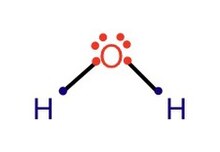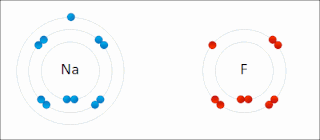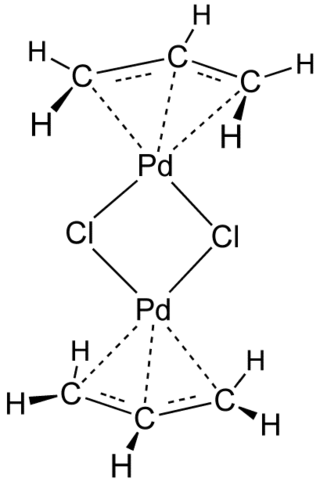Examples
For a water molecule (H2O), using both neutral counting and ionic counting result in a total of 8 electrons.

| Atom | Electrons contributed | Electron count |
|---|---|---|
| H. | 1 electron x 2 | 2 electrons |
| O | 6 electrons | 6 electrons |
| Total = 8 electrons |
The neutral counting method assumes each OH bond is split equally (each atom gets one electron from the bond). Thus both hydrogen atoms have an electron count of one. The oxygen atom has 6 valence electrons. The total electron count is 8, which agrees with the octet rule.

| Atom | Electrons contributed | Electron count |
|---|---|---|
| H+ | none | 0 electron |
| O2- | 8 electrons | 8 electrons |
| Total = 8 electrons |
With the ionic counting method, the more electronegative oxygen will gain electrons donated by the two hydrogen atoms in the two OH bonds to become O2-. It now has 8 total valence electrons, which obeys the octet rule.
- CH4, for the central C
- neutral counting: C contributes 4 electrons, each H radical contributes one each: 4 + 4 × 1 = 8 valence electrons
- ionic counting: C4− contributes 8 electrons, each proton contributes 0 each: 8 + 4 × 0 = 8 electrons.
- Similar for H:
- neutral counting: H contributes 1 electron, the C contributes 1 electron (the other 3 electrons of C are for the other 3 hydrogens in the molecule): 1 + 1 × 1 = 2 valence electrons.
- ionic counting: H contributes 0 electrons (H+), C4− contributes 2 electrons (per H), 0 + 1 × 2 = 2 valence electrons
- conclusion: Methane follows the octet-rule for carbon, and the duet rule for hydrogen, and hence is expected to be a stable molecule (as we see from daily life)
- H2S, for the central S
- neutral counting: S contributes 6 electrons, each hydrogen radical contributes one each: 6 + 2 × 1 = 8 valence electrons
- ionic counting: S2− contributes 8 electrons, each proton contributes 0: 8 + 2 × 0 = 8 valence electrons
- conclusion: with an octet electron count (on sulfur), we can anticipate that H2S would be pseudo-tetrahedral if one considers the two lone pairs.
- SCl2, for the central S
- neutral counting: S contributes 6 electrons, each chlorine radical contributes one each: 6 + 2 × 1 = 8 valence electrons
- ionic counting: S2+ contributes 4 electrons, each chloride anion contributes 2: 4 + 2 × 2 = 8 valence electrons
- conclusion: see discussion for H2S above. Both SCl2 and H2S follow the octet rule - the behavior of these molecules is however quite different.
- SF6, for the central S
- neutral counting: S contributes 6 electrons, each fluorine radical contributes one each: 6 + 6 × 1 = 12 valence electrons
- ionic counting: S6+ contributes 0 electrons, each fluoride anion contributes 2: 0 + 6 × 2 = 12 valence electrons
- conclusion: ionic counting indicates a molecule lacking lone pairs of electrons, therefore its structure will be octahedral, as predicted by VSEPR. One might conclude that this molecule would be highly reactive - but the opposite is true: SF6 is inert, and it is widely used in industry because of this property.

RuCl2(bpy)2 is an octahedral metal complex with two bidentate 2,2′-Bipyridine (bpy) ligands and two chloride ligands.
| Metal/ligand | Electrons contributed | Electron count |
| Ru(0) | d8 (8 d electrons) | 8 electrons |
| bpy | 4 electrons x 2 | 8 electrons |
| Cl . | 1 electron x 2 | 2 electrons |
| Total = 18 electrons |
In the neutral counting method, the Ruthenium of the complex is treated as Ru(0). It has 8 d electrons to contribute to the electron count. The two bpy ligands are L-type ligand neutral ligands, thus contributing two electrons each. The two chloride ligands hallides and thus 1 electron donors, donating 1 electron each to the electron count. The total electron count of RuCl2(bpy)2 is 18.
| metal/ligand | electrons contributed | number of electrons |
| Ru(II) | d6 (6 d electrons) | 6 electrons |
| bpy | 4 electrons x 2 | 8 electrons |
| Cl- | 2 electrons x 2 | 4 electrons |
| Total = 18 electrons |
In the ionic counting method, the Ruthenium of the complex is treated as Ru(II). It has 6 d electrons to contribute to the electron count. The two bpy ligands are L-type ligand neutral ligands, thus contributing two electrons each. The two chloride ligands are anionic ligands, thus donating 2 electrons each to the electron count. The total electron count of RuCl2(bpy)2 is 18, agreeing with the result of neural counting.
- TiCl4, for the central Ti
- neutral counting: Ti contributes 4 electrons, each chlorine radical contributes one each: 4 + 4 × 1 = 8 valence electrons
- ionic counting: Ti4+ contributes 0 electrons, each chloride anion contributes two each: 0 + 4 × 2 = 8 valence electrons
- conclusion: Having only 8e (vs. 18 possible), we can anticipate that TiCl4 will be a good Lewis acid. Indeed, it reacts (in some cases violently) with water, alcohols, ethers, amines.
- neutral counting: Fe contributes 8 electrons, each CO contributes 2 each: 8 + 2 × 5 = 18 valence electrons
- ionic counting: Fe(0) contributes 8 electrons, each CO contributes 2 each: 8 + 2 × 5 = 18 valence electrons
- conclusions: this is a special case, where ionic counting is the same as neutral counting, all fragments being neutral. Since this is an 18-electron complex, it is expected to be isolable compound.
- Ferrocene, (C5H5)2Fe, for the central Fe:
- neutral counting: Fe contributes 8 electrons, the 2 cyclopentadienyl-rings contribute 5 each: 8 + 2 × 5 = 18 electrons
- ionic counting: Fe2+ contributes 6 electrons, the two aromatic cyclopentadienyl rings contribute 6 each: 6 + 2 × 6 = 18 valence electrons on iron.
- conclusion: Ferrocene is expected to be an isolable compound.















